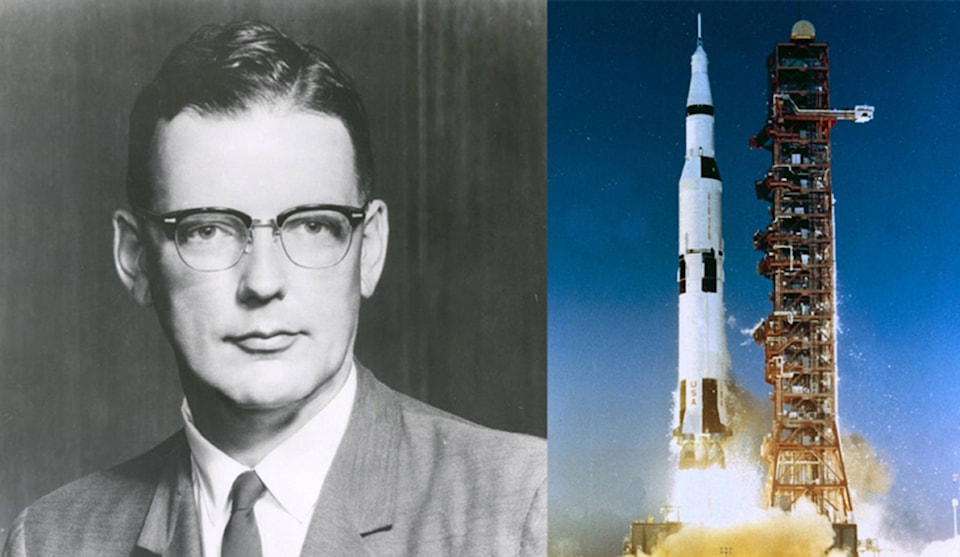As the world marks 50 years since man first landed on the moon, eyes are on those who helped take us there.
One of those people was Jim Chamberlin, a significant contributor to NASA’s success in manned spaceflight and a key figure in Canada’s aviation history.
He’s one of several subjects of interest to Royal Astronomical Society of Canada president Chris Gainor, who wrote about Chamberlin in his book Arrows to the Moon: Avro’s Engineers and the Space Race. Gainor spoke to KTW ahead of the moon landing anniversary on Saturday, July 20.
Jim Chamberlin was born in Kamloops, but his time in the city was brief. He was only here from his birth in 1915 until 1917, the year his father was killed at the Battle of Vimy Ridge.
He and his mother returned to Eastern Canada shortly after.
ALSO READ: South Surrey man helped beam images of moon landing around the globe
After graduating from the University of Toronto in 1936 with a degree in mechanical engineering, he earned a master’s degree at the Imperial College of Science and Technology in London, England, in 1939.
Upon returning to Canada, his aeronautics career got underway alongside the war effort, serving as chief engineer at Clark Ruse Aircraft in Dartmouth, N.S., where he worked on aircraft to counter submarines and for training, and later at Noorduyn Aviation in Montreal.
In 1946, Chamberlin became an engineer at Avro Canada, initially working as the chief aerodynamicist for the Avro C-102 jetliner and the Avro CF-100 jet interceptor before becoming the chief of technical design for the company as it began work on a keystone of Canadian aviation: the Avro Arrow.
The Arrow was thought to be the most advanced aircraft of its time, and Chamberlin was a key player in its twin-engined delta wing design.
But the project, which would have created Canada’s first supersonic jet fighters, was abruptly cancelled by Prime Minister John Diefenbaker in 1959.
| The Apollo 11 Lunar Module seen during its ascent stage after landing man on the moon. Astronauts Neil Armstrong and Buzz Aldrin are aboard. Jim Chamberlin promoted the idea of lunar orbit rendezvous — rather than landing a rocket directly on the moon — as the way forward for NASA. (NASA photo) |
But mere months after the Arrow was cancelled, Chamberlin joined the space race, recruited by NASA along with another two dozen Canadian engineers from Avro.
It wasn’t long before he became the head of engineering for Project Mercury, the effort that put astronaut Alan B. Shepard Jr. into space in a sub-orbital flight in 1961.
“But Mercury could only last so long and they wanted to have a spacecraft that could do more. So they thought, let’s fix up Mercury a little more, but Chamberlin said no — we need a new spacecraft,” Gainor said.
That new spacecraft was the precursor to the Apollo program.
“And that was where Gemini came from. He basically designed Gemini,” Gainor said.
Gainor said the Gemini spacecraft appeared similar to Mercury, but was actually quite different, incorporating modular design ideas Chamberlin brought with him from his time at Avro.
“It was quite an excellent spacecraft and it was a favourite of the astronauts — kind of considered like a sports car. I look at it as the offspring of the Arrow,” Gainor said.
Chamberlin served as the first program manager for Gemini before leaving the position in 1963 to do troubleshooting for the Apollo program, making direct contributions that led to its success.
Gainor said in the early days of NASA trying to figure out how to get to the moon, the agency was pursuing a direct approach that would land a rocket on the moon’s surface.
“But that introduces some problems because you’re carrying equipment to the lunar surface that you don’t need there, meaning you need a much bigger rocket,” he said.
Chamberlin was part of the reason that direct approach didn’t happen, with NASA instead opting to launch the lunar module from an orbiting spacecraft and then rendezvous to return back to Earth.
The idea itself came from John Houbolt, a NASA engineer who wasn’t working in human spaceflight, but was adopted and promoted by Chamberlin as the way to go forward.
“Chamberlin had a big role in promoting that. He heard about Houbolt’s ideas and looked at the math and realized it made a lot of sense,” Gainor said.
“I think that was one of his big gifts to NASA.”
Chamberlin left NASA to join McDonnell Douglas Astronautics in 1970, but before leaving, worked on early design concepts for the space shuttle — work that continued at his new private employer, where he contributed detailed design and development work on another highly successful NASA manned spaceflight venture.
Gainor never met Chamberlin before he died of a heart attack in 1981 at the age of 65, but did meet with other Avro engineers who went to Houston with him.
“They all say they weren’t necessarily better than the Americans were, but it just showed them we could go down there and work alongside the best in the world,” he said.
“I would be very surprised if Chamberlin felt any different about that, given what I know about him.”
